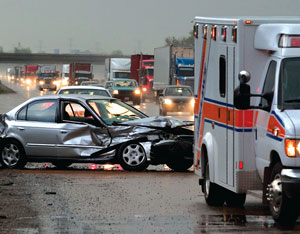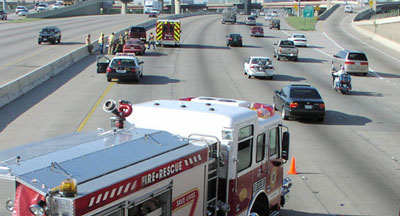Traffic Incident Management Outreach Toolkit:
Brochure
Printable Version [PDF 2.45MB]
PDF files can be viewed with the Acrobat® Reader®.
(Panel 1)
Traffic Incident Management
safe, reliable, travel, smooth, fast, response, timely, cost-saving, efficient

Buckle up: Wearing seat belts saves lives.
(Panel 2)
Traffic Incident Management Because Time Matters
Traffic Incidents…
…jeopardize the safety of motorists and responders
Every minute a lane is blocked, creates 4 extra minutes of delay. Every minute you're stuck in traffic increases your risk of being rear-ended.

…are a leading cause of unexpected highway congestion
…are costly
- Americans burn more than 2.8 billion gallons every year stuck in incident-related traffic.1
- Commuters lose nearly a full workweek (36 hours) sitting in traffic congestion each year.2
- Costs associated with traffic incidents due to medical bills and lost wages have jumped 85% in only four years.3
(Panel 3)
Traffic incidents are the #1 cause of death of EMS responders.4

Photo: iStockphoto
Traffic incidents create unsafe situations, put lives at risk, and cause delays.
Know your role:
- Move your car to a safe place – out of the travel lanes – if you are involved in an incident, and there are no injuries.
- When you see flashing lights ahead of you, you need to slow down and/or move over. You can be ticketed for failing to do this!
- Help keep your loved ones safe and avoid a ticket. Tell your friends and family about these laws.
(Panel 4)
Traffic Incident Management

Photo: Ron Moore
Traffic Incident Management responders work together to clear incidents safely and quickly.
But these heroes of the highway can't do it alone. They need our help. Please do your part to help keep everyone safe and moving on our roadways.
Sources:
1. U.S. DOT Strategic Plan FY 2010 – FY2015; April 15, 2010. [Return to text]
2. U.S. DOT Strategic Plan FY 2010 – FY2015; April 15, 2010. [Return to text]
3. Cambridge Systematics, Inc. 2011. Crashes vs. Congestion: What's the Cost to Society? Bethesda, Md.: AAA Foundation. [Return to text]
4. Maguire B, Hunting K, Smith G, Levick N. [2002]. Occupational fatalities in emergency medical services: a hidden crisis. Ann Emerg Med 40: 629. [Return to text]
(Panel 5)

Photo: Shutterstock

Photo: April H. Armstrong
T Traffic
I Incident
M Management
Working together, we can save lives and keep traffic moving on our roadways.
(Panel 6)
For more information, [provide website and contact information]
[Additional information - placement of logos here]
Federal Highway Administration
1200 New Jersey Ave., SE
Washington, DC 20590
https://ops.fhwa.dot.gov/tim/timtoolbox/

Buckle up: Wearing seat belts saves lives.